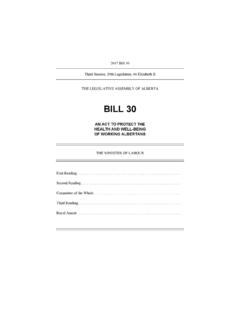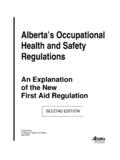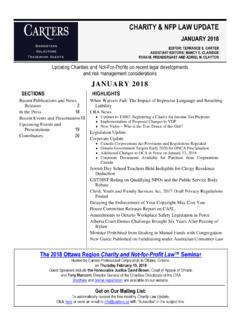Transcription of HISTORY AND LEGISLATIVE FRAMEWORK OF …
1 HISTORY AND LEGISLATIVE FRAMEWORK OF occupational health AND safety IN CANADA AN OVERVIEW 1. Brief HISTORY of OHS in Canada Up until the early twentieth century, employers were not responsible for providing compensation or care for injured workers unless the accident was deemed to be entirely the fault of the workplace. Here, the dominant legal doctrine of assumption of risk governed workplace hazards, which placed the onus on workers who, upon accepting employment, assumed and accepted all the risks associated with their occupation. However, the Long Depression of the 1870s resulted in worsening conditions for working Canadian men, women and children who were forced to toil longer hours for smaller wages under conditions that included a lack of health regulations, safety codes, welfare or access to compensation.
2 Concern for occupational health and safety (OHS) in Canada can be traced back to the late nineteenth century, when the Workmen s Compensation for Injuries Act (1886) of Ontario was introduced, establishing safety standards such as mandating guards on machines. In 1887, the Government of Canada struck the Royal Commission on the Relations of Capital and Labour in Canada to investigate the condition of working people across the Dominion. After documenting the testimonies of an estimated 1800 witnesses, the Commission concluded that there was a high level of injury among workers who experienced oppressive working conditions, and made several recommendations for improving OHS by establishing standards and mandating regular inspections, suggesting the creation of a system for compensating victims of industrial accidents regardless of who was at fault in the accident, and proposing that a labour bureau be created to oversee the development of OHS regulations.
3 In 1913, Justice William Meredith, who was appointed to a Royal Commission to study workers compensation, produced his final report, known as the Meredith Report, which outlined principles whereby workers relinquish their right to sue in exchange for compensation benefits. Specifically, the Meredith Principles advocated for no-fault compensation for injured workers, collective financial liability for the system to be shared by all employers, independent administration by an autonomous and non-political governing board, and exclusive jurisdiction wherein the governing board is the decision-maker and final authority for all claims. In 1919, the Association of Workers Compensation Boards of Canada (AWBC) was founded as a non-profit organization to facilitate the exchange of information between Workers Compensation Boards and Commissions.
4 By the early twentieth century, every province in Canada had created workers compensation boards and every jurisdiction in Canada had passed laws to regulate hygiene, lighting, heating, ventilation, accident reporting, and fire safety at factories. In 1974, the Ontario government formed the Royal Commission on the health and safety of Workers in Mines which articulated the following three key workers rights which have now formed the basis of much of the health and safety regulation and processes in Canada: a. The right to refuse dangerous work without penalty; b. The right to participate in identifying and correcting health and safety problems; and c. The right to know about hazards in the workplace. These rights continue to form an important basis for current OHS programming, processes and legislation in Canada.
5 2. OHS Legislation and Regulation in Canada OHS is regulated under a variety of mechanisms in Canada, including acts, regulations, standards, guidelines, and codes. These instruments outline the general rights and responsibilities of the employer, the supervisor and the worker. The scope of OHS legislation varies from jurisdiction to jurisdiction and each province and territory publishes its own regulations in addition to federal regulations. As such, all fourteen jurisdictions in Canada one federal, ten provincial and three territorial have its own OHS legislation. The majority of workers and workplaces are regulated by provincial or territorial legislation, with the exception of employees of the federal government and Crown agencies and corporations across Canada who are covered under federal legislation.
6 In addition to their LEGISLATIVE functions, governments conduct research on OHS issues and disseminate the information. Federal jurisdiction The federal OHS legislation is commonly referred to as the Canada Labour Code (Part II occupational health and safety ) and regulations. Approximately 10 per cent of the Canadian workforce falls under this jurisdiction, which also applies to employees of companies or sectors that operate across provincial or international borders. These workers include employees of airports, banks, exploration and development of petroleum on lands subject to federal jurisdiction, ferries, tunnels and bridges, pipelines, railways, shipping and shipping services and highway transport, among others. Federal statutes that are relevant to OHS include1: Canadian Charter of Rights and Freedoms, Part I of the Constitution Act 1982 Canadian Environmental Protection Act, 1985 Canada Labour Code, Part IV Hazardous Products Act, 1985 Pest Control Products Act, 1985 Transportation of Dangerous Goods Act, 1992, as amended Radiation Emitting Devices Act, 1985 Radiation Emitting Devices Act, 1985 The federal government has also created the Canadian Centre for occupational health and safety (CCOHS), a principal OHS research and resource organization governed by a tripartite Council representing government, employers and labour, to promote the health and well-being of Canadian workers.
7 In addition to maintaining its own comprehensive database, CCOHS accesses several 1 E. Kevin Kelloway, Lori Francis, James Montgomery, Management of occupational health and safety Third edition, 2006, p. 41. databases from around the world to collect and disseminate information on workplace health and safety , pandemic planning, workplace chemical hazards, the toxicological effects of chemicals and biological agents, chemical hazards, material safety data sheets, preventive measures for injuries and fatalities, workplace health information, and OHS legislation at the federal, provincial, and territorial levels. CCOHS provides health and safety information to any organization or worker who requests it.
8 Provincial and territorial jurisdiction Approximately 90 per cent of Canadian workers fall under provincial and territorial legislation. At this level, OHS legislation usually applies to all workplaces except private homes where work is done by the owner, occupant, or servants. Additionally, farming operations are generally not covered unless made to do so by specific regulation. Each provincial or territorial department is responsible for the administration and enforcement of its OHS acts and regulations. The statutes provide the legal foundation, while the regulations enacted under the statute establish the FRAMEWORK within which the employer will conduct business in order to comply with the law. At the provincial and territorial level, the name of the government department responsible for OHS varies with each jurisdiction.
9 Usually it is called a ministry or department of labour. In some jurisdictions, it is a workers' compensation board or commission that has the responsibility for occupational health and safety . Provincial and Territorial Statutes relevant to OHS considerations2: Transportation Environment Other Alberta Transportation of Dangerous Goods Act, 1982 Environment Protection Enhancement Act, 1992 British Columbia Transportation of Dangerous Goods Act, 1985 Waste Management Act, 1982/Amended 1990, 1992 Manitoba Dangerous Goods Handling and Transportation Act, 1987 Environment Act, 1987-88/Waste Reduction and Prevention Act, 1989-90 New Brunswick Transportation of Dangerous Goods Act, 1988 Newfoundland and Labrador Dangerous Goods Transportation Act, 1990 Department of Environment and Lands Act, 1990/Waste Material Disposal Act, 1990/Water Protection Act, 1990 Northwest Territories and Nunavut Transportation of Dangerous Goods Act, 1990.
10 2 Ibid, p. 42. Nova Scotia Transportation of Dangerous Goods Act, 1989 Environment Act (draft)/Litter Abatement Act, 1989 Ontario Dangerous Goods Transportation Act, 1990 Environmental Protection Act, 1990 as amended/Environmental Bill of Rights, 1993, 1993/Ontario Water Resources Act, 1990/Waste Management Act, 1992/Environmental Assessment Act Gasoline Handling Act, 1990/ health Protection and Promotion Act, 1990/ Municipal Act, 1990/Pesticides Act, 1990/Public health Act, 1980/Energy Act, 1990 Prince Edward Island Dangerous Goods Transportation Act, 1988 Environmental Protection Act, 1988 Quebec Environmental Quality Act, 1990 Saskatchewan Dangerous Goods Transportation Act, 1984085086 Litter Control Act, 1978 Yukon Dangerous Goods Transportation Act, 1986 Environment Act.







